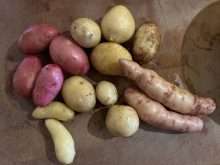How easily happiness begins by / dicing onions,” the late U.S. poet William Matthews wrote in his poem titled “Onions.” A little happiness, a little mercy, a little comfort in a hard world is what we all need just now. The scent of frying onions always makes me feel better, and one of my go-to comfort foods is Shanghai noodles with fried onions.
On a recent trip to Vancouver, my husband Dave and I were directed by a longtime chef friend and his partner, Stephen Wong and Nina Hooker, to a hole-in-the-wall joint in the West End called the Happy Noodle House. The place was small, about 25 seats, all filled despite the late hour: labourers with hard hats on the floor beside them, dressed-to-the-nines young women and men, a few grannies with yawning grandkids tucked on their laps struggling to master their chopsticks.
When our server brought the menu, I set it down and pointed to the table beside us where two young women were devouring plates of Shanghai noodles studded with shrimp and bok choy. It turns out I’d fortuitously chosen the house special. “I’ll have what she’s having,” I said, pointing at the noodles, copying Estelle Reiner’s deadpan delivery in the diner scene from her son Rob Reiner’s movie, When Harry Met Sally.
Read Also

Gentle treatments for pain in the neck
Heading toward year-end, people unknowingly tense up against the cold and busyness, causing neck pain that can often be treated with appropriate support and gentle mobility, athletic therapist Kathlyn Hossack says.
Ten minutes later, we made short work of a heaping plateful of hand-pulled Shanghai noodles redolent of wok hei, the near-mystical “wok energy” or caramelized smokiness that has been called the breath of a wok. It was an utterly sustaining and revivifying dish of comfort, soul food for hard times — an important path to a few minutes of peace in today’s harsh world.
If — like me and millions of other Canadians, since President Trump initiated tariffs on Canadian goods — you’ve been perusing label in the grocery store and setting made-in-the-U.S.A. products back on the shelf, you’ll be glad to learn there are Canadian-made Shanghai noodles. Dense and chewy, these noodles are easy to deal with. Simply pull them apart and cook them briefly in boiling water for several minutes, then add a soy-based sauce after sautéing onions, broccoli, bok choy, and your choice of protein.
There now, feel better. First we eat, then we talk politics in hard times.

Shanghai noodles with shrimp and bok choy
- ½ lb. fresh Shanghai noodles
- ¼ c. light soy sauce
- 1 Tbsp. dark soy sauce
- Hot chili oil or paste to taste
- 2 Tbsp. rice vinegar
- 1 Tbsp. sugar
- Oil for the pan
- 1 onion, sliced
- 4 cloves garlic, minced
- 1 Tbsp. minced ginger
- 1 carrot, thinly sliced on the diagonal
- 8 shrimp, peeled
- ½ c. broccoli florets
- 3 small bok choy, halved or quartered, or gai lan, chopped in 2-inch lengths
- 3 green onions, minced
- A handful of minced cilantro, optional
Pull apart the noodles and set them on a plate or tray. Combine the soy sauces, hot chili oil or paste, rice vinegar, and sugar in a small bowl.
Bring 2-3 quarts of water to boil in a large sauté pan or wok. Add the noodles and cook for 2-3 minutes. Drain and discard the water, leaving noodles in the pan.
Add the oil, onion, garlic, ginger, carrot and shrimp. Stir-fry for several minutes, then add the reserved sauce and mix to coat the noodles, adding a little extra dark soy if the colour isn’t dark enough to suit you. Mix well, then stir in broccoli and bok choy or gai lan. Cook briefly until just tender. Transfer to a serving bowl and top with green onions and optional cilantro.















